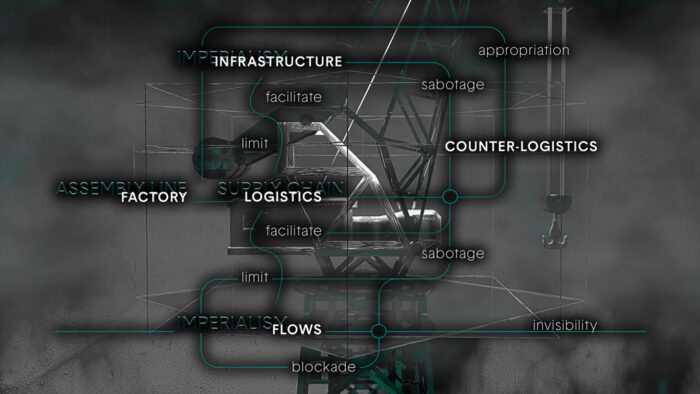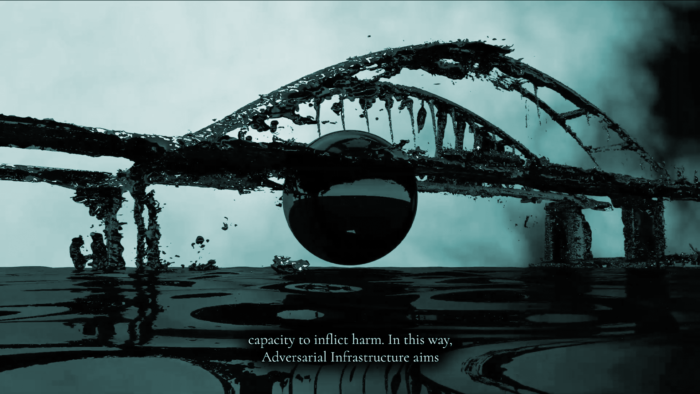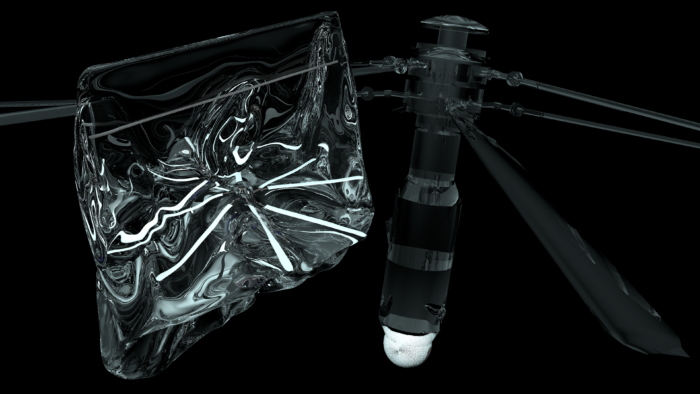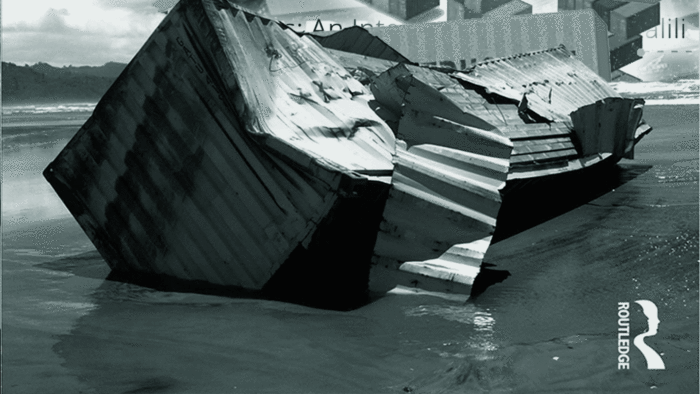Logistics Of Neocolonial Violence
An interview with artist and researcher Anna Engelhardt
Anna Engelhardt’s research focuses on the (de)colonial politics of algorithmic and logistical infrastructures in post-Soviet space. Being concerned with the notion of infrastructure as a form of politics, she develops her practice through writing and manufacturing digital infrastructures. She engages her background in critical theory to provide conceptual frameworks for her projects, conducting the investigations through the construction of virtual landscapes, materialized as online platforms and 3D computer graphics. Together with AUDINT, Anna Engelhardt co-produced the online project Protocols of Immanent Conflicts, commissioned by DEMO and Gossamer Fog.
Felice Moramarco: With your current research, you are investigating the transformation of colonial strategies in the neoliberal era and it turns out that logistics is becoming increasingly relevant within this context. Logistics has of course always been an important component of the colonial project, but now it seems that it has acquired an even more central position, what do you think are the causes of this transformation?
Anna Engelhardt: This transformation you mention was named in 2009 “supply chain capitalism” by Anna Tsing—the system, in which outsourcing became the heart of the production process, with wars and even torture now being outsourced. The logistical revolution solved the capital reaching its own glass ceiling, being unable to maintain an acceleration of extraction from the factories, and opened a new way to weaponize spaces in-between. Basically, that is how the just-in-time production started—rendering spaces between outsourcing facilities a part of the production process. Charmaine Chua uses a very telling anecdote to explain this mindset of contemporary regimes of exploitation: “it is now cheaper to ship freshly caught fish from the West Coast of the United States to China to be deboned and filleted by Chinese workers and then shipped back again than it is to pay for the cost of that work under U.S. labour regulations.” Since then, logistics as an industry has grown extensively, becoming a new place for a “political and class conflict,” as Alberto Toscano puts it, that comes along or even replaces the factory. Logistics today is “the new black” of the military-industrial complex – being the police, Amazon or proxy soldiers.

And you are also tracing a genealogy of this transformation.
Indeed, it has been a complex transformation with multiple genealogies, ranging from the spread of containers’ usage during the colonial war in Vietnam to the developments in cybernetics that allowed to calculate new geographies of goods’ distribution. To some extent, it is possible to say that the war in Vietnam in the 70s provided a kind of a “hardware”—standardized boxes that brought closer the fantasy of seamless flow that would facilitate the colonial expansion of capital. The cybernetics after the second world war was a “software,” that when merged with logistics in the 60s, allowed to schedule new “geographies of calculation”—plan distribution/outsourcing on the qualitatively new level. The role of cybernetics in the expansion of logistics is overviewed in the brilliant book “Software, Infrastructure, Labor: A Media Theory of Logistical Nightmares” by Ned Rossiter. Cybernetics could also be considered as a vital part of the logistical expansion in the Soviet Union—in his article “Is Data the New Gas?” Oleksiy Radynski highlights the way soviet cybernetic science materialized the oil pipeline infrastructures. Radynski’s research poses for me a particular interest, as researching Russian colonial strategies it is rare to find someone who would use logistics and infrastructure as a point of entry, especially from a historical perspective, which makes every encounter twice as exciting. Critical logistical studies as a field so far come from the Global North for the Global North. We tried to address this issue with my co-author, Sasha Shestakova, in a platform Intermodal Terminal that hosts decolonial reflections on logistics of post-Soviet space.

In terms of infrastructures, colonialism is traditionally associated with walls, fences and other systems to delimit and separate geographical areas, which allow for the military control of territories and populations. Conversely, bridges are considered to be elements that facilitate peaceful coexistence. Interestingly, in your Crimean Bridge project you suggest that bridges are actually the ultimate means of colonization in the neoliberal era. Can you explain what this paradigm shift in the colonial strategy entails?
This image of the interconnected world equated to peace is itself the product of the neoliberal era. In fact, interconnectedness under colonial and neocolonial regimes have always stayed for extraction and dispossession. Contemporary Western fascination with porous or moving borders lands differently in the spaces of colonial occupation, where borders are, indeed, one-way porous and mobile, allowing for colonial mobility. For such flow of imperial expansion, railroads have been the emblematic technology no less than forts, walls and barbwires. They are necessary to impose direct connection between empire and the colonized land, which is reflected by numerous scholars in critical logistical studies. The issue that I have come across during my research is that even though these projects of colonial logistics are problematized as violent, their functions are being reduced to the one of connection rather than separation. Numerous logistical researchers that I have read while conducting the project are talking about logistics as facilitating the flow, rather than restricting it, disrupting, or successfully combining these functions. Disruption of flow is typically portrayed as a drawback or a side effect of logistics. For contemporary regimes, logistical infrastructures like airports and harbors are usually surrounded by an aura of vulnerability—they are the bottlenecks of logistics—and require enormous security infrastructures to protect them. Nevertheless, it would be counterintuitive to assume somehow that the primary function of the airport would be security control rather than flying to the desired destination.
That is why I felt the need to introduce my term—adversarial infrastructure—to describe cases in which logistics aim to disrupt the flow as one of its primary functions. I used the term “adversarial” from the “adversarial machine learning”, in which antagonistic functions of the algorithms amplify each other instead of neutralizing. In the adversarial infrastructure, such capacity to simultaneously connect and disrupt amplifies the function of inflicting colonial violence. In my project, this infrastructure is the Crimean Bridge. It connects the occupied Crimean Peninsula to the Russian land while imposing a blockade for the ships that attempt to go to Ukrainian harbors. Nevertheless, during my research, I found numerous other instances when infrastructures were meant to hide the function of disrupting the flow behind the one of flow facilitation. It was the case, for instance, when Robert Moses built the automobile bridges too low for public transport to segregate poor and rich people in the city, as well as numerous other infrastructural policies that imply segregation. I would say that adversarial infrastructure as a military technology entails enormous obfuscation and denial of responsibility for actions, making it a favorable tool for colonial wars.

Another aspect of this paradigm shift is also the development of new systems of warfare—“neoliberal wars” are usually not declared, military operations are denied and carried out by proxies rather than regular armies, is this another significant symptom of the ways in which colonialism currently takes place?
Such outsourcing of responsibility, warfare, torture, violence, in general, have been highlighted by Anna Tsing, as I have mentioned above, as a significant shift in the system of a new iteration of capitalism. Nevertheless, even though such a system of extensive distribution makes it easier to hide its connections, It is important to remember that the space that experiences colonial violence is always space for which the dichotomy of war and peace would be blurred. The areas of death—what Achille Mbembe calls necropolitics—have always been successfully erased from the daily life of the empire. This erasure, ironically, strikes back with what Derek S. Denman calls the colonial boomerang, the phenomenon when a violent strategy, first tested and implemented in the colony, is brought back to the empire to be deployed against its population. Denman’s research seems to be quite relevant to this conversation. In his paper The logistics of police power: Armored vehicles, colonial boomerangs, and strategies of circulation he talks about the impossibility to claim “militarization of the police” due to the circulation and neverending exchange that happens between military and police forces. He traces the connection between them through the logistics of weapons they use, bringing us back to the question of the role logistics plays in the obfuscation and distribution of military forces.
Logistics is, initially, a military art. It was born, according to Deborah Cowen, to solve the problem of fueling the battlefield. It has been for a long time on the background of the military actions, considered as inherently secondary towards them, but making them possible in the first place. Later, logistics got adopted and was made to the forefront in the seemingly civilian capitalist production. The division between civilian and military logistics should be operated quite carefully, though, as it is not legitimate in the majority of cases. Not only military goods and people are being transported by private companies and in most cases through civilian infrastructures with other “normal” goods on board, but also vice-versa—“many of WalMart’s managers and executives—who set the standard for the industry as a whole — come from the military,” as tells us Jasper Bernes. It creates conditions in which the blurred line between these two categories becomes the smokescreen for the warfare, making it harder to distinguish from seemingly non-militarized flows of capital.

Following this “logistic turn”, it becomes evident that warfare and circulation of commodities share the same logics and infrastructures. Lenin once wrote that “capitalism bears war within itself as the cloud bears the storm”, do you think this total indifferentiation between war and capitalism is the ultimate accomplishment of that statement? So that capitalism doesn’t simply lead to war (as in Lenin’s opinion), but it has actually become indistinguishable from war.
I like the quote you use from Lenin in the sense that it summarizes the tension I feel when I read yet another paper on logistics. If for Lenin capitalism bears the war within itself, for logistical researchers both capitalism and war is fitted in the container. The obsession of scholars with containers got on my nerves so much that I started taking screenshots every time I would encounter yet another picture of the magic matryoshka box that fits the whole military-industrial complex inside—and there was enough to make a GiF. This idea that there is one box that can fit all systems of oppression inside is counterproductive by definition. Not only in the sense that logistics is not equal to containers and such ignorance towards visual language one is working with inevitably leads to the fallacies in the logic of the researcher. But also in the sense that even though we must problematize the distinction between civilian and military, war and peace, these categories cannot be replaced with one conceptual box that would be able to accommodate all intricacies of these phenomena without the emergence of unsolvable contradictions. I would say it might be productive to think of these categories—capital and war—as being distributed spatially in a heterogeneous manner. Some places would be exposed to military violence much more than others, even though it would be hard to draw a clear line where military violence ends.
Nevertheless, migrating from these spaces might be impossible. In her lecture The Refugee Crisis and the Racial (B)order of Global Capital Denise Ferreira da Silva highlights the impossibility for those who are forced to be in the zones of violence to leave them, as they encounter similar racialized abuse even if they migrate somewhere else. It means these geographies, even though being distinct from each other, bleed into one another through racialized systems of oppression. Indeed, it is also vital to bear in mind that neoliberal capitalism is also unevenly distributed spatially. If we speak of authoritarian regimes like Russia or totalitarian regimes like Belarus, we will find capital being significantly dependent on and intertwined with the state. Even in supposedly democratic countries like the UK, we can see Brexit happening, making the partial rule of the state over capital apparent. It means that questioning the terms we operate with—like war—we must not conceptually erase existing differences that these terms are meant to signify.

In one of your works—Colonial Sediments—you also highlight the negative impact that the intensification of logistics has on the environment, do you think this can be considered yet another form of invisible violence currently caused by neoliberalism?
I would say that it is yet another negative impact of the anthropocene. In the video, Sasha and I are looking into the infrastructure of intermodal terminals in Russian port city Nakhodka. Intermodal terminal is the space where the goods—coal in the case of Nakhodka—are being transported. These spaces accumulate the frictions, poisonous sediments and harmful traces of the logistical flows that while on the go perceived as frictionless. The violence inflicted in these logistical chokepoints, as Charmaine Chua names them, usually remains hidden behind the substitution of political restrictions by technical constraints. In Nakhodka, such “mechanical” restraint is the impossibility to breathe as the only available state for the local residents. Intermodal terminals in Nakhodka work through open coal transportation. Openness, in this case, implies the lack of any barriers that would contain coal dust that shipping makes bleed in the surrounding environment, fueling the ecological collapse.
The ecological collapse happening in Nakhodka presents a case of how anthropocene is, in fact, multiple and situated. The coal dust there comes from the acceleration of capital that is not only caused by the growth in the consumption but also Paris environmental agreement. Prospective ban on coal that Paris agreement implies sets the mindset for the coal industry that they must extract as much as they can now. Therefore, it leaves enough time for the ecology of the area to be destroyed entirely due to the accelerated pace of coal transportation. Ecological law that brings further ecological collapse makes it evident that it is important to approach anthropocene as anthropocenes, following Kathryn Yusoff, to address the locality of the global climate change that is embodied in the multiplicity of the logistical infrastructures at play.



